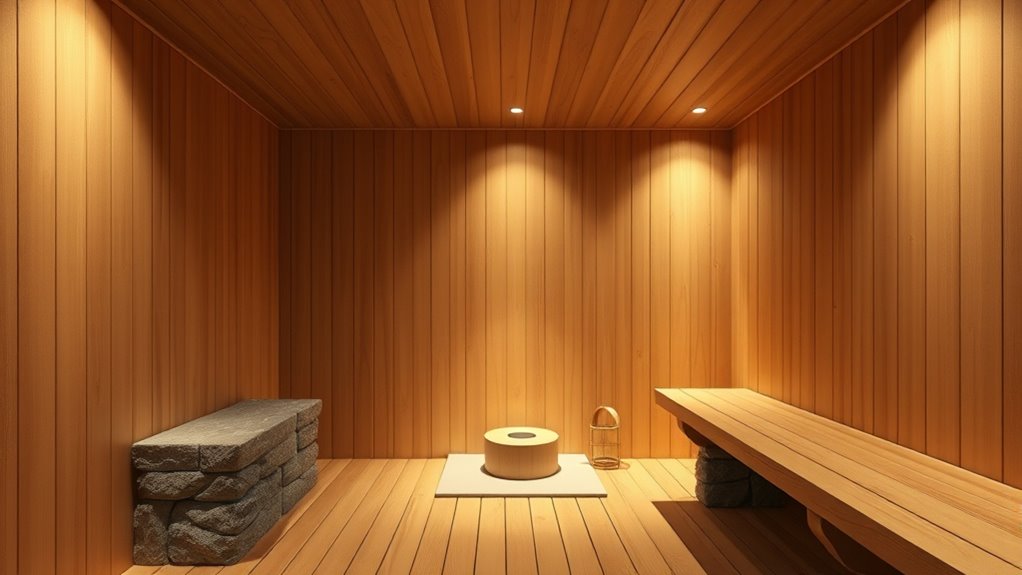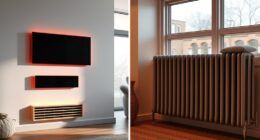To size your sauna heater properly, you need to measure your room’s length, width, and height accurately to find the total volume. This helps you select a heater wattage that heats efficiently without safety risks. Remember to take into account insulation, ventilation, and materials, as these factors impact heat retention and energy use. For effective comfort and safety, getting these details right is key—keep going to discover more expert tips.
Key Takeaways
- Measure sauna dimensions accurately to determine total room volume for proper heater sizing.
- Match heater wattage to room volume, considering insulation quality and heat retention properties.
- Avoid oversizing or undersizing heaters to ensure stable temperatures and safety.
- Prioritize proper insulation and ventilation to improve heat retention and reduce energy use.
- Learn from existing setups by adjusting heater capacity based on actual performance and comfort feedback.
Understanding the Basics of Sauna Room Volume
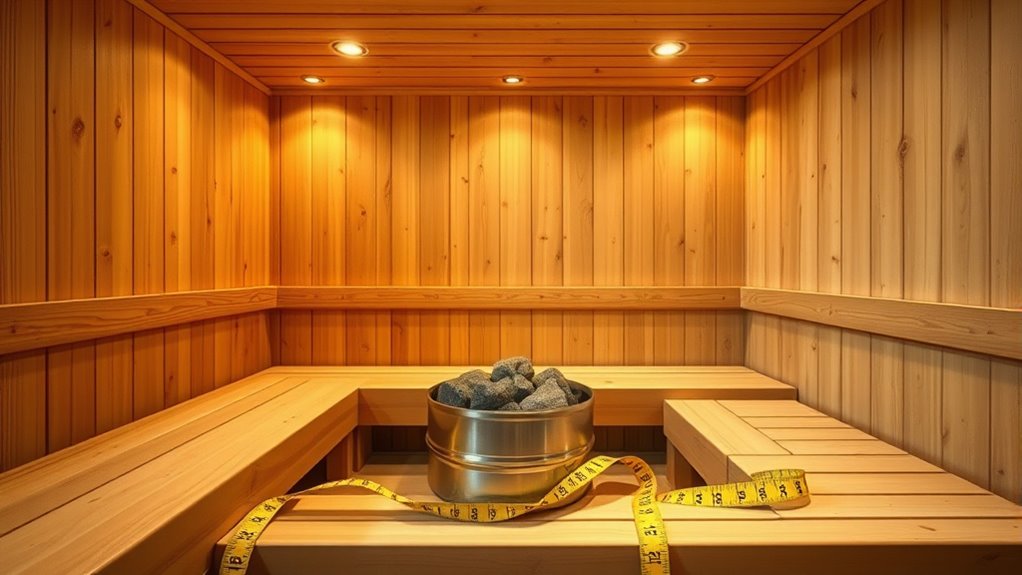
To properly size a sauna heater, you first need to understand the basics of sauna room volume. Knowing your room’s size helps determine the right heater power. Consider the wood types used, as some woods like cedar or hemlock retain less moisture and affect humidity control. Thicker or denser woods may require a slightly larger heater to maintain consistent temperatures. Humidity control plays a role too; higher humidity levels demand more heat, so knowing your preferred moisture levels guides your sizing decisions. Measure your sauna’s length, width, and height accurately. This gives you the total volume, which is vital for selecting a heater that heats efficiently without wasting energy or falling short of temperature needs. Accurate sizing ensures a comfortable, well-regulated sauna experience. Understanding your sauna’s environment can further optimize heater selection and performance.
How Heater Power Affects Temperature Control
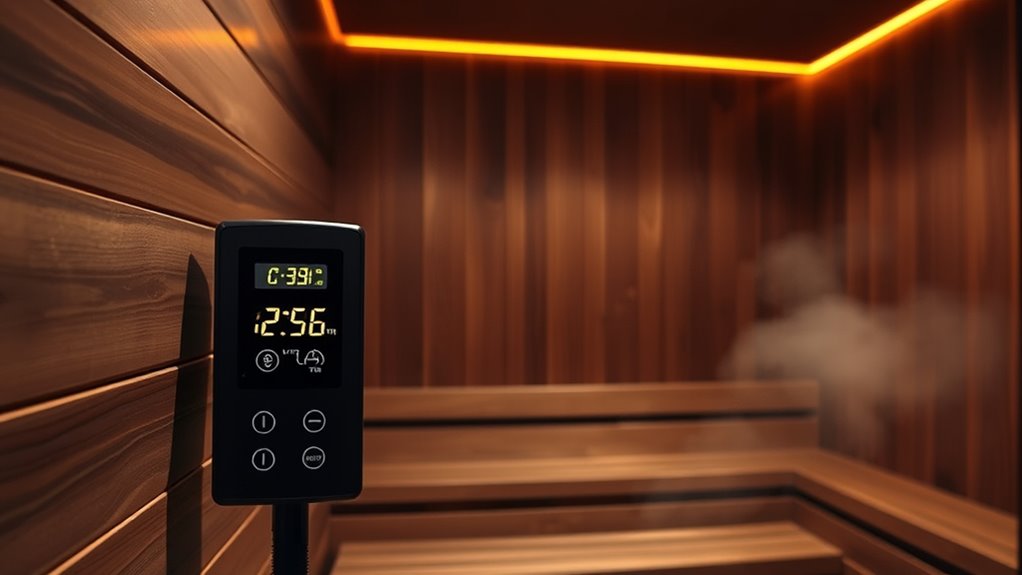
The power of your sauna heater directly impacts how quickly it heats the room and maintains the desired temperature. If the heater is too powerful, you might risk overheating or losing precise control, while a weaker heater could struggle to reach your target warmth. Understanding these factors helps you choose a heater that provides stable, safe temperature regulation. Additionally, selecting a heater with appropriate wattage ensures optimal performance without compromising safety or efficiency.
Power and Heating Rate
Heater power directly influences how quickly and accurately you can control the temperature in your sauna. A more powerful heater heats the space faster, allowing you to reach your desired temperature quickly. However, higher power also means increased energy consumption, so you need to balance efficiency with performance. Oversized heaters may overshoot the target temperature, making precise control difficult, while undersized units struggle to reach the desired heat. Making sure your heater meets safety standards is vital, as excessive power can pose safety risks if not properly installed or rated for your room size. Selecting the right heater power ensures effective temperature control without unnecessary energy waste or safety concerns. Proper sizing helps you enjoy a comfortable, safe sauna experience with reliable heating performance. Additionally, understanding power and heating rate can help optimize your sauna’s heating efficiency and longevity.
Temperature Stability Factors
When heater power is appropriately matched to your sauna’s size, it plays a crucial role in maintaining temperature stability. A properly sized heater responds efficiently to temperature changes, preventing fluctuations that can disrupt your experience. Consistent heat helps regulate humidity levels by maintaining steady ambient temperature, avoiding overly dry or damp conditions. If the heater is too powerful, it may overshoot the target temperature, causing instability. Conversely, a heater that’s too weak struggles to sustain consistent heat, leading to temperature swings. By matching heater capacity to your sauna’s volume, you ensure better control of ambient temperature and humidity regulation. This balance creates a comfortable, stable environment, making your sauna sessions more enjoyable and predictable. Proper sizing is essential for maximum temperature stability and overall sauna performance. Additionally, understanding the temperature control mechanisms of your heater can further enhance your sauna experience by optimizing heat distribution and response.
Overheating Risks
If your sauna’s heater is too powerful for the space, it can quickly lead to overheating and temperature control issues. This increases safety risks, such as burns or equipment damage. To prevent this, you should follow safety precautions like installing temperature limits and monitoring devices. Proper ventilation requirements are also critical; inadequate airflow can trap heat and create dangerous conditions. An oversized heater heats the room too quickly, making it difficult to maintain a stable, safe temperature. Always match heater power to your sauna’s volume, ensuring it doesn’t produce excessive heat. Regularly checking ventilation and temperature controls helps you avoid overheating risks, keeping your sauna safe and comfortable for everyone. Proper sizing and precautions protect you from unnecessary hazards and equipment failures. Additionally, understanding the importance of room volume can help in selecting the correct heater size for optimal safety and efficiency.
Real-World Examples of Sizing Successes and Failures

Real-world examples show how proper sizing leads to comfortable, efficient saunas, while mistakes can cause discomfort or energy waste. Understanding successful strategies helps you avoid common pitfalls that undermine your setup. Let’s explore what works and what doesn’t in sauna heater sizing. Ethical hacking techniques emphasize thorough reconnaissance and careful analysis, which are essential steps in ensuring your sauna system is correctly configured to prevent issues before they occur.
Successful Sizing Strategies
Achieving the right heater size for your sauna often hinges on applying proven strategies and learning from both successes and failures. Effective sizing starts with understanding your sauna’s room volume and considering how humidity control impacts comfort. Successful projects often incorporate these strategies:
- Accurate room measurements to determine proper heater wattage
- Balancing aesthetic design with functional heating elements
- Using a heater with adjustable humidity controls for flexibility
- Prioritizing insulation to optimize heat retention
- Consulting manufacturer guidelines and real-world user feedback
- Incorporating emotional intelligence to better interpret user comfort preferences and adapt heating solutions accordingly
Common Mistakes to Avoid
Choosing the wrong heater size is a common mistake that can lead to uncomfortable sauna experiences or energy waste. Oversizing causes unnecessary energy consumption, while undersizing results in inadequate heating. Additionally, errors like incorrect wiring can create safety hazards, and inadequate insulation hampers heat retention, making your heater work harder. To avoid these pitfalls, consider these key mistakes:
| Mistake | Consequence | Solution |
|---|---|---|
| Incorrect wiring | Safety risks, heater malfunction | Hire a qualified electrician |
| Inadequate insulation | Heat loss, higher energy bills | Insulate thoroughly |
| Wrong heater size | Poor heating, energy waste | Follow proper sizing guides |
Avoid these mistakes for a safe, efficient, and comfortable sauna experience. Proper hackathons can sometimes provide innovative solutions for optimizing heater sizing and insulation techniques.
Common Mistakes to Avoid When Selecting Heaters
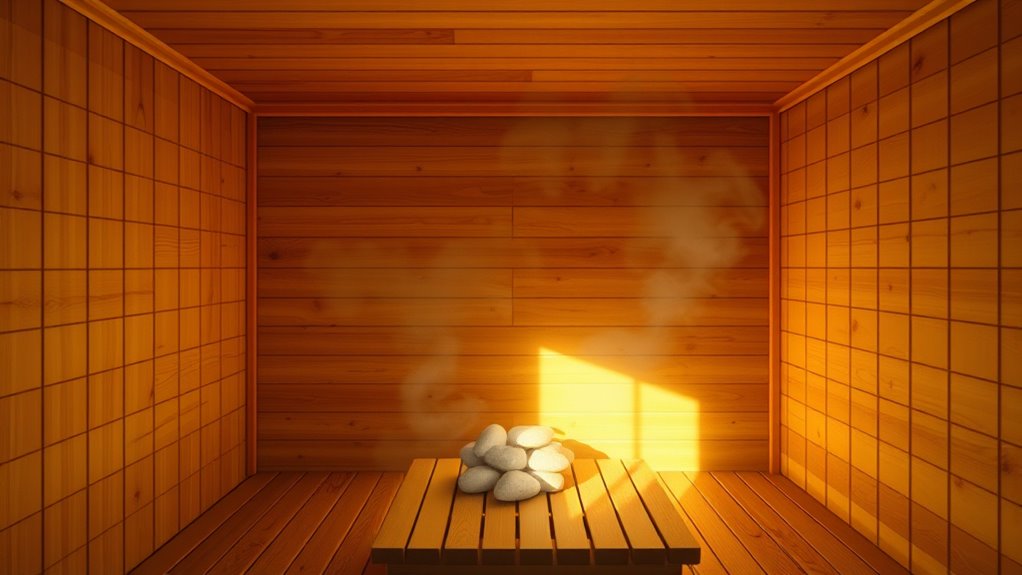
One common mistake people make when selecting sauna heaters is overlooking the importance of accurately calculating the room’s volume. This can lead to choosing a heater that’s too small or too large, causing inefficiency or discomfort. Additionally, neglecting insulation techniques can make a heater work harder than necessary, wasting energy. Poor lighting design might tempt you to install inadequate heating, affecting the overall experience. To avoid these pitfalls, consider:
- Ignoring proper insulation, leading to heat loss
- Underestimating or overestimating room size
- Choosing a heater without matching its wattage to room volume
- Overlooking ventilation effects
- Failing to plan for ideal lighting and aesthetic integration
- Failing to account for ventilation and air circulation, which are crucial for efficient heater performance and safety
Being precise with calculations and mindful of these factors ensures a heater that works perfectly for your sauna.
Adjusting for Insulation and Ventilation Factors
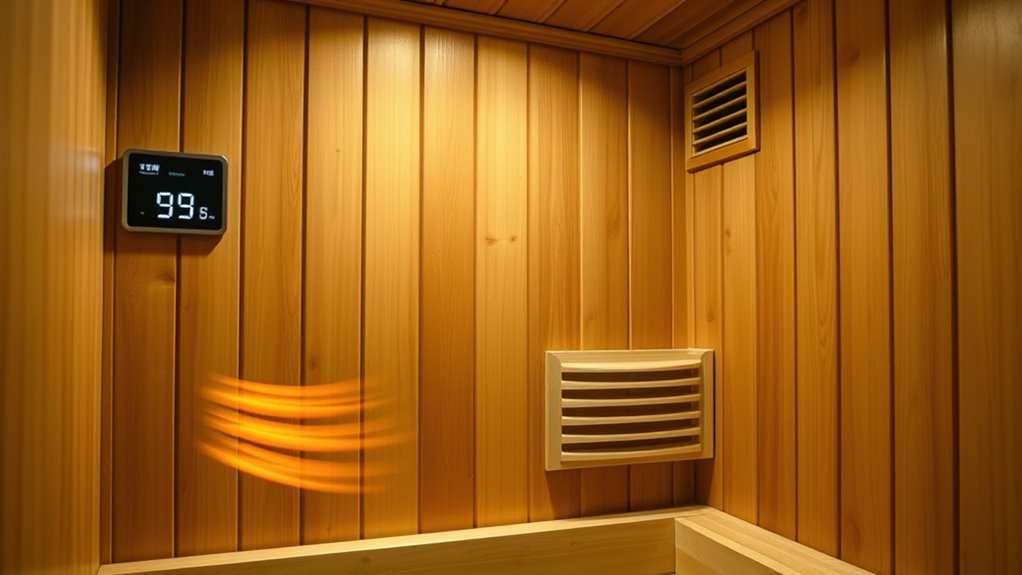
Accurately sizing your sauna heater requires more than just measuring the room’s volume; it also involves accounting for how well your space retains heat and how fresh air moves through it. Insulation effects play a vital role—better insulation reduces heat loss, meaning you may need a smaller heater. Conversely, poor insulation causes heat to escape faster, requiring a more powerful unit. Ventilation impacts are equally important; good airflow ensures fresh air, but excessive ventilation can lower the temperature and increase heating demands. You should adjust your heater size based on these factors. If your sauna has high-quality insulation and controlled ventilation, you can size your heater closer to the room’s volume. Conversely, poor insulation and high ventilation rates mean you’ll need to compensate with a larger heater. Additionally, heat retention qualities of the materials used in your sauna construction can significantly influence the size of the heater needed.
Tips for Fine-Tuning Your Sauna for Optimal Comfort

To achieve the best sauna experience, paying attention to small adjustments can make a big difference in comfort. Regular sauna maintenance ensures ideal heater performance and consistent heat, enhancing user comfort. Fine-tuning your sauna involves simple tweaks that elevate the experience:
Small adjustments and regular maintenance create a more comfortable, enjoyable sauna experience.
- Adjust the vent openings for better air circulation.
- Use a hygrometer to monitor humidity levels and add water to the stones accordingly.
- Keep the heater clean to prevent uneven heating.
- Insulate door seals to maintain stable temperature.
- Experiment with seating heights to find your preferred warmth zone.
These small tweaks help you personalize your sauna environment, making each session more enjoyable. Remember, consistent sauna maintenance not only prolongs equipment life but also ensures a comfortable, safe experience every time.
Lessons Learned From Experienced Sauna Builders
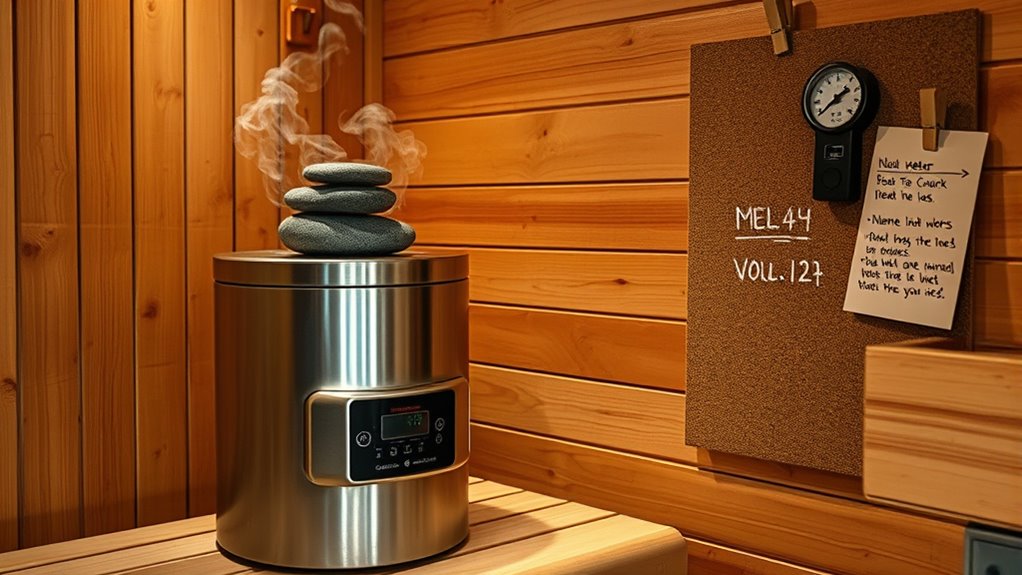
Learning from seasoned sauna builders can save you time and prevent costly mistakes. They emphasize the importance of thoughtful sauna design, ensuring the room’s size and shape promote even heat distribution. Pay close attention to material selection; high-quality, moisture-resistant woods like cedar or hemlock are essential for durability and comfort. Experienced builders advise avoiding cheap or untreated materials that can warp or emit unwanted odors. They also recommend planning for proper ventilation and insulation from the start, as these elements impact heater efficiency and overall safety. Listening to their lessons helps you balance aesthetics with functionality, ensuring your sauna heats efficiently and lasts for years. Applying these insights streamlines your project and results in a safer, more enjoyable sauna experience.
Frequently Asked Questions
How Do I Calculate the Ideal Heater Size for Irregularly Shaped Saunas?
To calculate the ideal heater size for irregularly shaped saunas, start by breaking the space into manageable sections and measure each area’s dimensions. Use volume calculations for each section, then add them to find the total sauna volume. Keep in mind that irregular shapes can be tricky, so add about 10-15% to your total for proper heating efficiency. This guarantees your heater can handle the unique layout comfortably.
What Safety Precautions Should I Consider When Installing Sauna Heaters?
Your safety is more important than a rocket launch, so follow essential precautions. Always guarantee proper electrical wiring by hiring a qualified electrician, avoiding overloaded circuits. Keep fire safety in mind by installing a heat-resistant barrier behind the heater and maintaining clearances from combustible materials. Regularly inspect the heater and wiring for damage, and never operate it with exposed wiring or in wet conditions. These steps protect you and make your sauna experience safe and enjoyable.
How Does Humidity Level Influence Heater Selection and Room Volume?
Humidity impact plays a vital role in heater selection and room volume. Higher humidity levels can reduce heater efficiency, requiring a more powerful heater to maintain desired temperatures. If your sauna has elevated moisture, choose a heater designed for humid environments to prevent damage and guarantee safety. Properly evaluating the humidity impact helps you select the right heater size, guaranteeing optimal performance and a comfortable sauna experience.
Can I Retrofit an Existing Sauna With a Different Heater Size?
Think of your sauna as a musical instrument; upgrading the heater is like changing its strings. Yes, you can retrofit a different heater size, but heater compatibility and retrofit challenges must be carefully contemplated. You’ll need to guarantee the new heater fits the space and matches your sauna’s volume. Be prepared for potential wiring adjustments and thermal balance issues, making the upgrade a delicate dance rather than a simple swap.
What Maintenance Tips Extend the Lifespan of Sauna Heating Elements?
To extend the lifespan of your sauna heating elements, prioritize regular cleaning maintenance to prevent dust and mineral buildup, which can cause overheating. Inspect the elements periodically for signs of wear or damage. When necessary, opt for heater replacement with compatible parts to guarantee peak performance. Proper cleaning and timely replacements help you avoid costly repairs, keep your sauna running smoothly, and prolong the life of your heating elements.
Conclusion
Getting your sauna room volume and heater size right can make all the difference in creating a cozy, effective space. Do you want a sauna that heats quickly, stays warm, and feels just right? By understanding the basics, avoiding common pitfalls, and fine-tuning your setup, you can enjoy a perfect sauna experience every time. Remember, the right balance isn’t just about numbers—it’s about creating a warm retreat you’ll love to return to.
